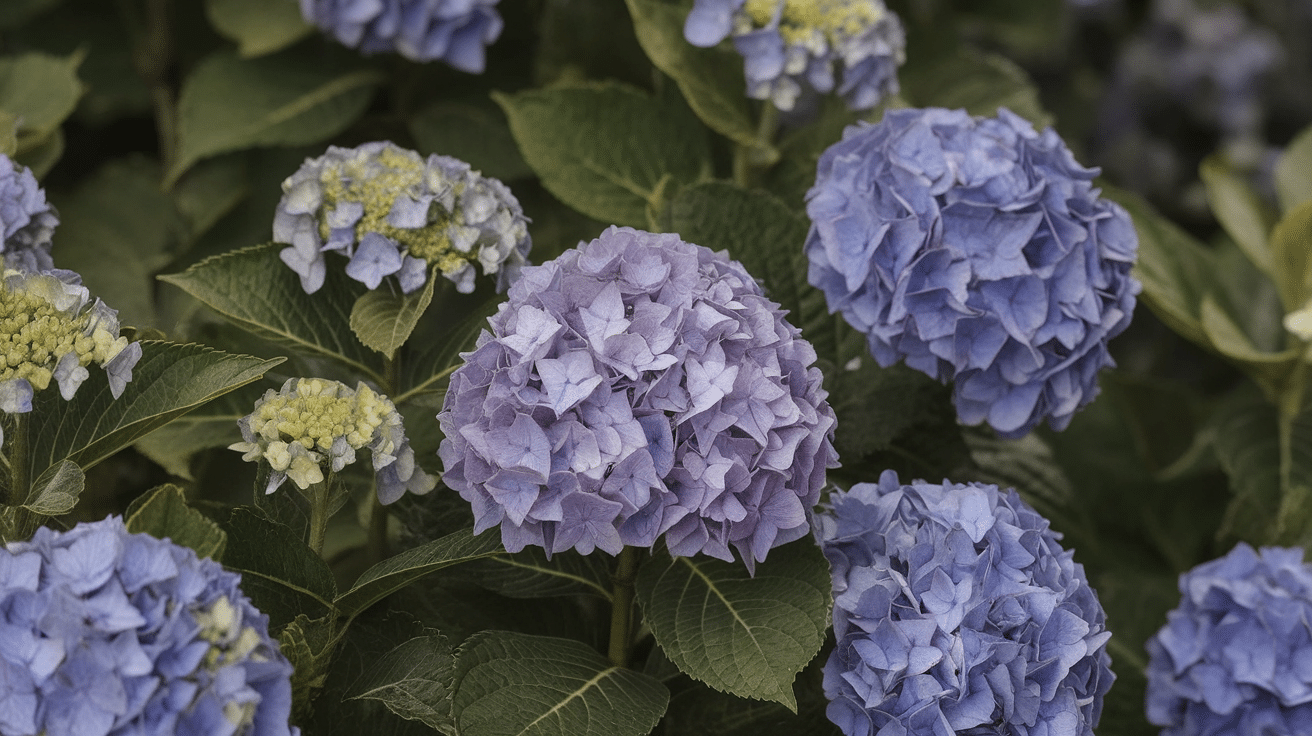Hydrangeas are some of the most loved plants in gardens around the world. With their big, colorful blooms and lush green leaves, they can make any yard or patio look amazing.
But if you’ve ever seen your hydrangea start to droop or wilt, you know how sad that can be. A wilting hydrangea doesn’t just look unhappy—it’s usually a sign that something isn’t quite right.
In this post, we’ll talk about the most common reasons why hydrangeas wilt, how you can figure out what’s causing it, and what you can do to fix it.
If you’re new to gardening or just looking to learn more, this guide will help you keep your hydrangeas healthy and blooming.
Common Causes of Hydrangea Wilting

Wilting can happen for many reasons. Sometimes, it’s simple, like needing water. Other times, it could be due to too much heat, pests, or even planting issues.
1. Not Enough Water
Hydrangeas love water. In fact, the name “hydrangea” comes from the Greek word for water! These plants have big leaves and flowers that lose water quickly. If they don’t get enough to drink, they can droop fast. You might notice wilting in the afternoon, especially on hot, sunny days. This is usually a sign your plant needs more water.
2. Too Much Water or Poor Drainage
Believe it or not, watering too much can also cause wilting. If your soil doesn’t drain well, the roots can sit in water and start to rot. When the roots rot, the plant can’t take in water properly—even if the soil is wet. This can make your hydrangea look dry and droopy.
3. Extreme Temperatures
Hydrangeas don’t like too much heat. On very hot days, they can wilt just from the stress of the heat, even if the soil is moist. Cold weather can also shock the plant and cause wilting, especially if it’s been moved indoors or outside too quickly.
4. Transplant Shock
If you recently moved your hydrangea or planted a new one, it might be going through transplant shock. This is when the plant gets stressed from being disturbed, especially if the roots are damaged, or the conditions change suddenly. It can show up as wilting, even if everything else seems fine, and may take several days to recover fully.
5. Pests and Diseases
Insects like aphids or spider mites can suck the juices from your plant and make it wilt. Fungal diseases like root rot or leaf spot can also weaken the plant and lead to wilting. These problems are usually easy to spot if you look closely at the leaves and stems.
As you can see, there are quite a few things that can cause your hydrangea to wilt. But don’t worry—once you figure out what’s causing it, you can take the right steps to help your plant bounce back.
Diagnosing the Cause of Wilting
Before you can fix the problem, you need to figure out what’s causing it. Here are some easy ways to check what’s going on with your hydrangea.
1. Check the Soil: Stick your finger a couple of inches into the soil. If it feels dry, your plant probably needs water. If it’s wet and soggy, your plant may be getting too much water or doesn’t have good drainage.
2. Look for Pests: Check under the leaves and around the stems for tiny bugs or webs. Aphids, spider mites, and other pests can hide there and suck the life out of your plant. If you see small holes or sticky leaves, that’s a sign of pests.
3. Check the Weather: Think about the recent weather. Has it been really hot or really cold? Sudden changes in temperature can cause wilting. Hot days can dry out the plant quickly, while cold drafts can shock it.
4. Think About Recent Changes: Did you just plant your hydrangea or move it to a new spot? If so, transplant shock might be the cause. It takes time for roots to settle and adjust.
Once you’ve checked the soil, leaves, and weather, you’ll have a better idea of what your hydrangea needs. A little detective work goes a long way in saving your plant!
How to Revive a Wilting Hydrangea

Seeing your hydrangea wilt can be stressful, but the good news is—there’s hope! In many cases, a wilted hydrangea isn’t dying; it’s just asking for some care and attention. With a few simple steps, you can help your plant bounce back and look as good as new again.
Step 1: Check the Soil
Start by feeling the soil with your fingers about 2–3 inches deep.
- If it’s dry, Your hydrangea is probably thirsty. Dry soil means your plant isn’t getting enough water.
- If it’s soggy: The roots may be too wet or starting to rot. Too much water can be just as harmful as too little.
What to do: If the soil is dry, give your plant a deep watering. Water at the base of the plant until the soil is moist—not muddy. If the soil is too wet, stop watering and let it dry out a bit before watering again.
Step 2: Water Properly
Hydrangeas prefer deep, slow watering rather than light, quick splashes. Water early in the morning so the plant has time to absorb the moisture before the heat of the day.
How to water:
- Water at the base of the plant, not on the leaves.
- Use a soaker hose or watering can to apply water slowly.
- Water 2–3 times a week during hot weather, depending on your soil type.
Step 3: Provide Some Shade
If your hydrangea is in full sun all day, the heat may be causing it to wilt. Even well-watered hydrangeas can droop if the sun is too intense.
What to do:
- Move potted hydrangeas to a shadier spot, especially in the afternoon.
- For garden hydrangeas, try using a shade cloth or planting something nearby that provides light shade.
Step 4: Prune Dead or Damaged Leaves
Cut off any leaves or flowers that are clearly wilted beyond recovery or turning brown. This helps your hydrangea focus its energy on new growth and healing.
Tip: Use clean, sharp garden scissors or shears to avoid damaging the plant.
Step 5: Check for Pests
If you see bugs or tiny webs, treat your plant with insecticidal soap or gently wash the leaves with a hose. Inspect the leaves, stems, and even the soil for signs of insects like:
- Aphids
- Spider mites
- Mealybugs
Step 6: Improve Drainage
Poor drainage can lead to root rot, which is a common cause of wilting.
If your plant is in a pot:
- Make sure there are drainage holes.
- Use a well-draining soil mix.
If your plant is in the ground:
- Mix compost or sand into the soil to help it drain better.
- Avoid planting in low-lying areas where water pools.
Step 7: Don’t Overdo It
Sometimes, trying to fix the problem too quickly can cause more harm. Avoid:
- Overwatering in a panic
- Over-fertilizing (this can burn the roots)
- Moving the plant too often
After giving your hydrangea the right care, wait a few days and monitor it. Most healthy plants will start to bounce back within 24–72 hours of being watered and shaded properly.
Reviving a wilting hydrangea takes some observation, care, and a little patience. In most cases, once you find the problem—whether it’s lack of water, too much sun, or poor drainage—you can take the right steps to help your plant recover. And once it does, it will reward you with those big, beautiful blooms that make hydrangeas so special.
Hydrangea Varieties Less Likely to Wilt

Some hydrangea types are naturally tougher and handle heat, sun, and dry spells better than others. If you live in a hot or dry area or you want low-maintenance blooms, choosing the right variety can make a big difference.
-
Panicle Hydrangeas (Hydrangea paniculata): These are some of the hardiest hydrangeas out there. They love the sun, handle heat well, and aren’t as thirsty as other types. Their cone-shaped flowers are also super pretty and long-lasting.
-
Smooth Hydrangeas (Hydrangea arborescens): Known for their big, round flower heads, smooth hydrangeas like ‘Annabelle’ are very tolerant of both heat and cold. They recover quickly after drooping and are great for beginners.
-
Oakleaf Hydrangeas (Hydrangea quercifolia): These are native to the U.S. and have large leaves shaped like oak trees. They handle dry conditions better than most hydrangeas and are perfect for partly shaded spots.
-
Endless Summer Series (Reblooming Hydrangeas): While they still need care, Endless Summer hydrangeas are bred to be tough and bloom all season long. They bounce back quickly after stress and can handle a mix of sun and shade.
Choosing one of these varieties can save you time, water, and worry. They’re not completely wilt-proof, but they’re definitely more forgiving when things get hot or dry!
Preventive Measures
Now that you know what’s wrong let’s see how to fix it. These simple solutions will help bring your hydrangea back to life and keep it healthy in the future.
1. Water the Right Way: Water deeply, but not too often. Aim to keep the soil moist, not soaking. Early morning is the best time to water so your plant can soak it up before the sun gets too hot.
2. Improve Drainage: If your soil holds too much water, try mixing in compost or sand to help it drain better. Make sure the pot (if you’re using one) has holes in the bottom to let water escape.
3. Give It Some Shade: Hydrangeas like some sunlight but not too much. Morning sun and afternoon shade work best. If your plant is wilting in the heat, try moving it to a spot with more shade or use a shade cloth.
4. Watch for Bugs: Look for pests. You can gently wash them off with water or use insecticidal soap if needed. The sooner you spot bugs, the easier they are to get rid of.
5. Be Gentle When Transplanting: If you’re moving your hydrangea, do it in cooler weather—spring or fall is best. Be careful with the roots, and water well after replanting to help it settle in.
With the right care and attention, your hydrangeas can recover from wilting and look even better than before. These simple habits will keep them strong and blooming all season long.
Conclusion
Wilting hydrangeas can be frustrating, especially when you’ve put so much care into growing them. But the good news is, most of the time, wilting is your plant’s way of asking for a little extra help.
Whether it’s from too little water, too much sun, or a bit of transplant shock, there are simple ways to fix the problem and help your hydrangeas bounce back.
By learning how to spot the cause, watering the right way, providing proper shade, and choosing hardy varieties, you can keep your hydrangeas looking their best all season long.
Remember, every garden has its ups and downs, but with a little attention and care, your hydrangeas will reward you with big, beautiful blooms. Don’t get discouraged—just keep observing, adjusting, and growing. Your garden will thank you for it, and your hydrangeas will be back to blooming before you know it!
Frequently Asked Questions
How often should I water my hydrangeas?
In warm weather, water 2–3 times per week, making sure the soil stays moist but not soaked. Deep watering is better than frequent, light watering.
What does transplant shock look like in hydrangeas?
Wilting, drooping leaves, and a general “tired” look after moving or planting are common signs. Give it time, water gently, and provide shade if needed.
Can wilting be a sign of disease?
Yes, wilting can also be caused by root rot or pests like aphids or spider mites. Check the leaves and roots for damage, spots, or bugs.

